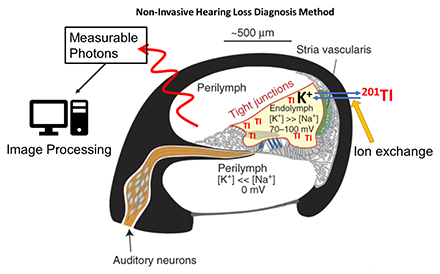Advantages:
- Microenvironment Sensitivity: Unveils subtle structural changes within the cochlear microenvironment, enhancing auditory health understanding.
- Treatment Response Tracking: Precisely quantifies potassium concentration changes, enabling accurate monitoring of treatment responses and disease progression.
- Non-Invasive Approach: Offers a patient-friendly, non-invasive method for auditory assessment, transforming hearing diagnostics accessibility and acceptance.
Summary:
The forefront of technological advancement is embodied by our state-of-the-art nuclear imaging methodologies, integrating the application of Thallium-201 (201TI) as a remarkably efficient radiotracer. This innovation facilitates the visualization and comprehensive assessment of the intricate physiological nuances within the cochlea through a non-invasive approach. The distinctive contribution of our method lies in its illumination of the critical role played by the stria vascularis in producing the specialized potassium-rich medium essential for optimal auditory function. The exceptional attribute of symmetrical 201TI absorption, coupled with the precise tracking of fluctuations in potassium concentration, sets our approach apart, effectively bridging a crucial void in the realm of auditory diagnostics. This emergence as an indispensable tool for hearing specialists, audiologists, and researchers underscores its ability to enable accurate, real-time, and non-invasive evaluation of auditory conditions, redefining precision and insight in the field.

201TI (thallium) is the mild radioactive tracer that’s used to help the cochlea communicate with an image processor to determine the magnitude of “cochlear battery”-related hearing loss.
Desired Partnerships:
- License
- Sponsored Research
- Co-Development